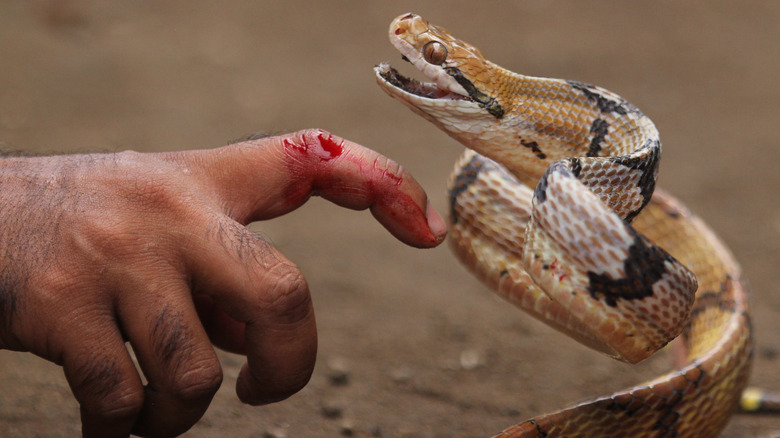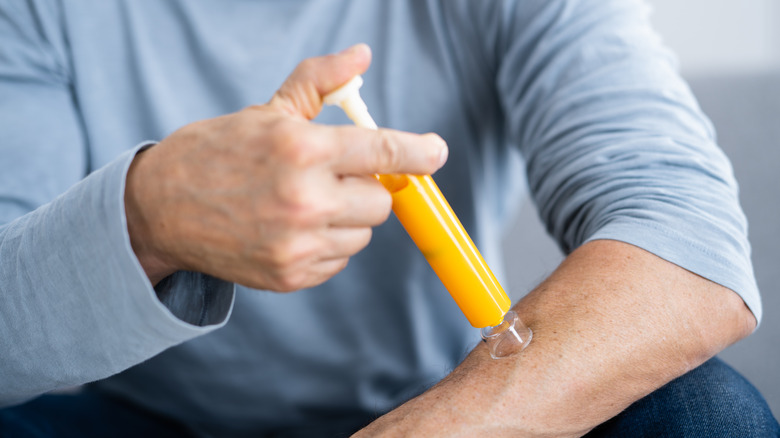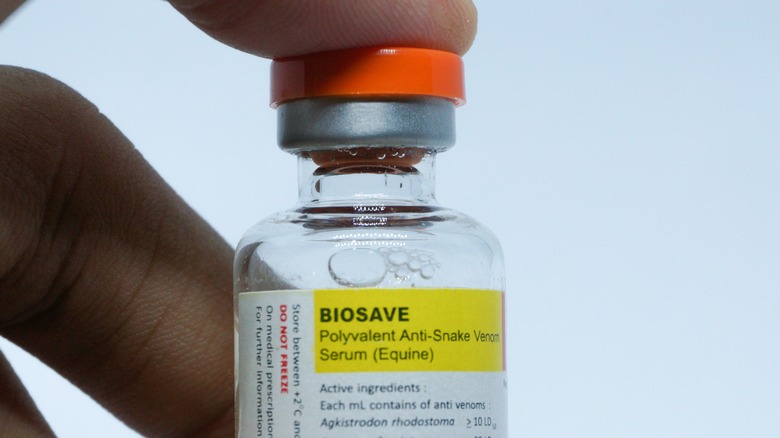Is It Safe To Suck The Venom Out Of A Snake Bite?
Perhaps this plot line sounds familiar. You're watching an old classic Western or wilderness survival movie and as the cast traipses through the jungle or across the dusty desert, suddenly, one of the characters gets bit by a snake. Acting quickly, our hero swoops in to cut open the wound and suck the venom out of the snake bite. While this may appear effective on the silver screen, is sucking the venom out of a snake bite a safe and efficient life-saving measure?
"Throughout the spring and summer months, the numbers (of snakebite-related ER visits) double, triple, maybe even more than that," Dr. Diane Calello, an associate professor of emergency medicine at Rutgers New Jersey Medical School in Newark, tells WebMD. However, venomous snake bite-related deaths are relatively rare in the U.S., killing approximately five people per year. Coral snakes, rattlesnakes, copperheads, and cottonmouth snakes are all venomous species of snakes found in the U.S. While symptoms can vary, signs of a snake bite include redness, swelling, severe pain, labored breathing, vomiting, numbness, increased salivation, and more, reports the U.S. Centers for Disease Control and Prevention (CDC).
In the event you unexpectedly cross paths with a snake, there are some key things you should keep in mind, particularly what not to do.
The dangers of snake bite suction
Despite the widespread belief that sucking on a snake bite can remove the venom from the body, Dr. Calello tells WebMD that doing so is both ineffective and potentially dangerous, as you run the risk of transferring some of the poison from the bite into your mouth. This can be particularly dangerous if you have an open cut in your mouth, notes How Stuff Works. As this provides a direct pathway for the venom into your bloodstream. Vice versa, you also run the risk of transferring bacteria from your mouth into the snake bite wound, thereby increasing your chances of infection.
Rather than sucking on a snake bite with our mouth, perhaps you're thinking, what about using the sucking device found in snake bite first aid kits? A 2004 scientific review published in Annals of Emergency Medicine looked at the effectiveness of the commercially available snake bite suction device known as the Sawyer Extractor pump. Using mock venom, researchers found that the device removed approximately 0.04% to 2% of the amount of mock venom dispersed, rendering the tool "essentially useless," as written in the research.
Treatment for snake bites
So what should you do instead if you're bitten by a snake? The CDC advises keeping as still and calm as possible. Reducing your heart rate and keeping the bite wound physically below the heart slows the spread of venom throughout the body, notes How Stuff Works.
Additionally, you should immediately call 911 or head to the nearest emergency room for antivenom treatment. Antivenom is purified antibodies against venom or certain components found within it, explains the University of Melbourne.
In the meantime, remove any constricting jewelry in the event of swelling. You should also take note of the size and color of the snake so that you can relay these details to your doctor (per WebMD). Things you should not do after a snake bite include icing the wound, cutting open the wound, using a tourniquet, submerging the bite in water, or using alcohol or blood-thinning pain relievers, as these measures can lead to further damage, notes the CDC.
Snake bite prevention
The best thing you can do is to avoid snake bites in the first place. Remember, compared to the snake, you're larger and more intimidating. Therefore, most snakes will try and make a run for it before attacking. In fact, researchers from a 2002 study published in Copeia attempted to provoke a number of cottonmouth snakes by encroaching on their space, stepping on them, and picking them up. Study findings showed that most of the snakes gave off defensive warning signs or slithered away rather than bite.
Mental Floss further reports that up to one-quarter of snake bites are considered "dry bites," or void of venom. The release of venom requires a good bit of energy, therefore, they may opt to preserve it.
WebMD says other preventative measures include carrying a walking stick, wearing protective clothing, and carrying a flashlight. The CDC advises avoiding areas where snakes tend to be like under rocks, in the water, or underneath fallen trees.
In the event of a natural disaster, snakes may be forced out of their natural environment. Should you find a snake in your home, don't attempt to kill or trap it. Contact Animal Control instead.
The shape of a snake's pupils can give you a clue whether it is venomous (per Mental Floss). Round pupils generally indicate a non-venomous snake while elliptical pupils indicate they are probably venomous. Additionally, venomous snake bites generally have two puncture holes, while non-venomous snake bites are a more rounded, shallow U-shape.




